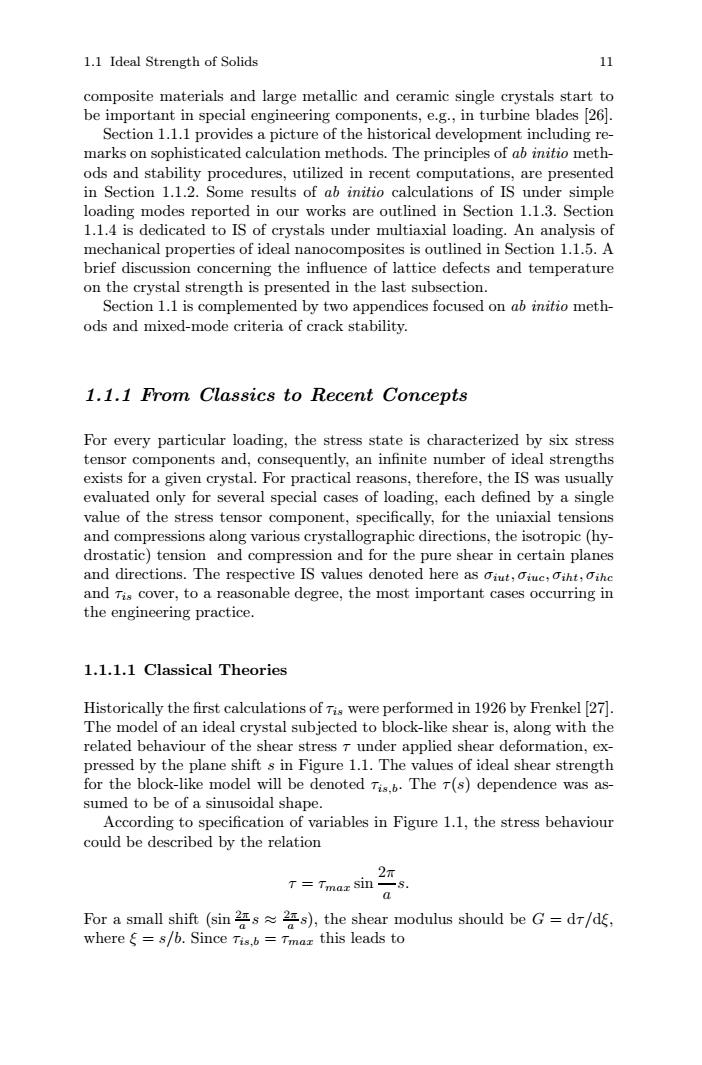正在加载图片...

1.1 Ideal Strength of Solids 11 composite materials and large metallic and ceramic single crystals start to be important in special engineering components,e.g.,in turbine blades 26. Section 1.1.1 provides a picture of the historical development including re- marks on sophisticated calculation methods.The principles of ab initio meth- ods and stability procedures,utilized in recent computations,are presented in Section 1.1.2.Some results of ab initio calculations of IS under simple loading modes reported in our works are outlined in Section 1.1.3.Section 1.1.4 is dedicated to IS of crystals under multiaxial loading.An analysis of mechanical properties of ideal nanocomposites is outlined in Section 1.1.5.A brief discussion concerning the influence of lattice defects and temperature on the crystal strength is presented in the last subsection. Section 1.1 is complemented by two appendices focused on ab initio meth- ods and mixed-mode criteria of crack stability. 1.1.1 From Classics to Recent Concepts For every particular loading,the stress state is characterized by six stress tensor components and,consequently,an infinite number of ideal strengths exists for a given crystal.For practical reasons,therefore,the IS was usually evaluated only for several special cases of loading,each defined by a single value of the stress tensor component,specifically,for the uniaxial tensions and compressions along various crystallographic directions,the isotropic (hy- drostatic)tension and compression and for the pure shear in certain planes and directions.The respective IS values denoted here as oiut,oiue,oiht,oihe and Tis cover,to a reasonable degree,the most important cases occurring in the engineering practice. 1.1.1.1 Classical Theories Historically the first calculations of Tis were performed in 1926 by Frenkel 27. The model of an ideal crystal subjected to block-like shear is,along with the related behaviour of the shear stress r under applied shear deformation,ex- pressed by the plane shift s in Figure 1.1.The values of ideal shear strength for the block-like model will be denoted Tis.6.The r(s)dependence was as- sumed to be of a sinusoidal shape. According to specification of variables in Figure 1.1,the stress behaviour could be described by the relation 2T T Tmaz sin -s. a For a small shift(sin2红s≈红s),the shear modulus should be G=dr/d, where =s/b.Since Tis,=Tmaz this leads to1.1 Ideal Strength of Solids 11 composite materials and large metallic and ceramic single crystals start to be important in special engineering components, e.g., in turbine blades [26]. Section 1.1.1 provides a picture of the historical development including remarks on sophisticated calculation methods. The principles of ab initio methods and stability procedures, utilized in recent computations, are presented in Section 1.1.2. Some results of ab initio calculations of IS under simple loading modes reported in our works are outlined in Section 1.1.3. Section 1.1.4 is dedicated to IS of crystals under multiaxial loading. An analysis of mechanical properties of ideal nanocomposites is outlined in Section 1.1.5. A brief discussion concerning the influence of lattice defects and temperature on the crystal strength is presented in the last subsection. Section 1.1 is complemented by two appendices focused on ab initio methods and mixed-mode criteria of crack stability. 1.1.1 From Classics to Recent Concepts For every particular loading, the stress state is characterized by six stress tensor components and, consequently, an infinite number of ideal strengths exists for a given crystal. For practical reasons, therefore, the IS was usually evaluated only for several special cases of loading, each defined by a single value of the stress tensor component, specifically, for the uniaxial tensions and compressions along various crystallographic directions, the isotropic (hydrostatic) tension and compression and for the pure shear in certain planes and directions. The respective IS values denoted here as σiut, σiuc, σiht, σihc and τis cover, to a reasonable degree, the most important cases occurring in the engineering practice. 1.1.1.1 Classical Theories Historically the first calculations of τis were performed in 1926 by Frenkel [27]. The model of an ideal crystal subjected to block-like shear is, along with the related behaviour of the shear stress τ under applied shear deformation, expressed by the plane shift s in Figure 1.1. The values of ideal shear strength for the block-like model will be denoted τis,b. The τ(s) dependence was assumed to be of a sinusoidal shape. According to specification of variables in Figure 1.1, the stress behaviour could be described by the relation τ = τmax sin 2π a s. For a small shift (sin 2π a s ≈ 2π a s), the shear modulus should be G = dτ /dξ, where ξ = s/b. Since τis,b = τmax this leads to